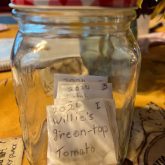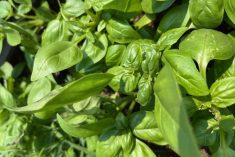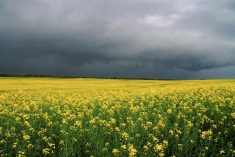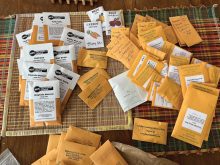Hey there and hi, y’all good people! Ted here and welcome to the program. This is the final Grainews issue for 2023. Are you into the Christmas spirit yet?
Just as Rudolph is the most famous reindeer of all, according to a seasonal song, echinacea is famous for its contribution to helping humans stay well. No wonder I’ve lately been singing “The Flu Bug Song” and “The Prostate Song,” two tunes I wrote and recorded more than 20 years ago.
Besides its constant beauty in a flower garden, echinacea is a useful remedy when colds, flu, runny noses, sniffles and tickles in the throat are rampant. Lots more on said subject is coming up.
Read Also

Gentle treatments for pain in the neck
Heading toward year-end, people unknowingly tense up against the cold and busyness, causing neck pain that can often be treated with appropriate support and gentle mobility, athletic therapist Kathlyn Hossack says.
Dare I ask how your Christmas baking coming along? Even if some of you aren’t into making cookies, cake, mincemeat or other Christmas treats anymore, the smell of fresh-baked goodies for the holiday season emanating from the kitchen will stir up warm memories of past days.
One thing I vividly recall is sampling a homemade Christmas cake basted with a touch of rum or rum flavouring to help it cure well in advance of December 25.
Let’s get the show underway. The gesture of any gentleman tipping his hat is not out of style.
Echinacea
Echinacea plants begin to pump out their magnificent purple-mauve flowers from late spring and early summer right through into early fall and beyond. They have elongated hollow stems that grow up to a metre high, and hairy leaves that are long and narrow.
Dragonflies and butterflies love to use echinacea flowers as landing pads. Various birds will also pay visits to feast on seeds once the seed cone matures.
Echinacea’s name is rooted in the Greek word echinos, meaning hedgehog, in reference to the spiky appearance and feel of the flower heads. It is also known as purple cone flower, which comes from the characteristic cone at the centre of each flower head.
Echinacea is a popular herbal remedy, coming in various forms and potencies, and it has long been used around the word for its various health benefits. For instance, there are historical records of some indigenous tribes in North America using echinacea as a pain reliever and to treat sore throats, colds and headaches.
Today, echinacea is accepted by herbalists for its solid reputation as a bacteria fighter, immune booster and a remedy to help fight some long-standing health issues.
For many, this medicinal herb is the undisputed champion among immune system boosters for helping protect against common upper respiratory afflictions and reducing the severity and duration of symptoms.
What else might echinacea do? Recent studies highlight it as a potential mild, natural antidepressant, indicating it may help lift mood and soothe anxiety. It seems echinacea also has tissue regenerative properties, which could help with eczema, psoriasis, skin ulcers, acne, wounds and burns.
Today, echinacea can be purchased from health and natural food stores and some pharmacies. It is available in capsules, tablets, teas, tinctures, emulsions and creams.
Echinacea products vary widely in composition and may contain different species such as E. angustifolia, E. purpurea and E. pallida. Recommended amounts will vary widely depending on the condition being addressed.
One of the most extensive studies on the safety of echinacea products concluded that overall “adverse events are rare, mild and reversible.” Allergies are rare, but if you do react to an echinacea remedy, discontinue further use and ask your health care provider for guidance on whether there’s a different form you can use.
Consult with a holistic doctor or herbalist before using echinacea for the first time to determine the formula and dosage that’s right for you.
Immunity
Is immunity inherited, acquired or both?
Natural immunity is the kind you inherit from your parents. If Dad and Mom rarely miss a day’s work and for the most part are both pictures of health, then chances are you will have a strong immune system too.
But regardless of how good your genes are, if you don’t have a nutritious diet and you don’t exercise regularly, walk much, have a garden or find other ways to relieve stress, you could be short-changing yourself. That’s because stress can compromise your immune system.
The answer to the question is therefore: Immunity is both inherited and acquired.
From my inbox
I’m a bit of a diverse writer at times. A reader from out Vancouver way picked up on that about my writing. Here’s some of what a lady named Marg writes in her email from October 13:
“Hello from the West Coast. I like reading farm magazines (I grew up on a small farm out here) and I like the positive, practical newsy tone of your articles. My Albertan husband and friends were just on the beautiful VIA train from Toronto heading west through Winnipeg, Portage, Melville, Saskatoon, Edmonton, Jasper, etc. … I wonder, are there any natural original prairies left and where are they? Or have they all been cultivated for our food and other use? The Prairies are beautiful. We’re lucky to have some meadowlark birds too in open ranch lands (in the) Okanagan in B.C. Thank you from Greater Vancouver, Marg (last name withheld).”
My response: “Thanks Marg for writing. I too love the trills of meadowlarks that have often visited open fields near my garden space during summers past. I have audio recordings of a local man who had a special gift for duplicating several different yet accurate meadowlark musical notes with his voice. He told me each one had a different meaning and described the meadowlarks’ musical notes as “a mastering of vibration and movement of the tongue.”
Somewhat similar to yodeling I, Ted, would say.
OK, I’m turning next to gardeners, farmers and birders: This is your opportunity to answer Marg’s question: Are there any natural original prairies left and where are they? Send what you know and care to share with Grainews readers by email.
Rum frosting
I’ve got a quick recipe to share for real rum or rum-flavoured frosting. I think you’ll like it even though it’s quite sweet.
In a mixer bowl beat together three tablespoons softened butter, 1/2 teaspoon rum flavouring or real rum and 1/2 teaspoon vanilla extract. Beat in 1/2 cup sifted icing sugar.
Gradually add about two more cups or less of sifted icing sugar and two or three tablespoons of evaporated milk or cream or regular milk.
Keep beating until the frosting is smooth and spreads easily. Tint with food colouring if desired. Drizzle over mincemeat pudding, pie, tarts, Christmas cake, gingerbread cookies or other treats.
What life’s about
Life is not about waiting for the storms to pass. It’s about caring and loving our family, relatives and friends while we can touch and see them and they are still among us. May we always walk in sunshine even during the shortest, darkest days of the year.
















